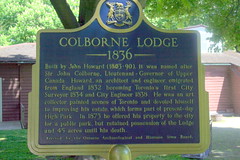John Howard
John Howard
(1803-1890)
architect, engineer, art collector, painter, City Surveyor (1834-1838), and City Engineer (from 1838)
Commemorated on 1 plaque
Colborne Lodge 1836 Built by John Howard (1803-90), it was named after Sir John Colborne, Lieutenant-Governor of Upper Canada. Howard, an architect and engineer, emigrated from England 1832 becoming Toronto's first City Surveyor 1834 and City Engineer 1838. He was an art collector, painted scenes of Toronto and devoted himself to improving his estate, which forms part of present-day High Park. In 1873 he offered his property to the city for a public park, but retained possession of the Lodge and 18 ha until his death.
Colborne Lodge Drive, High Park, Toronto, ON, Canada where they designed (1835) and lived (1835-1890)

